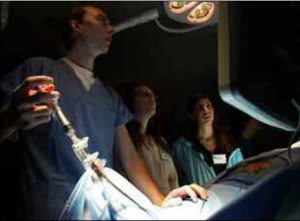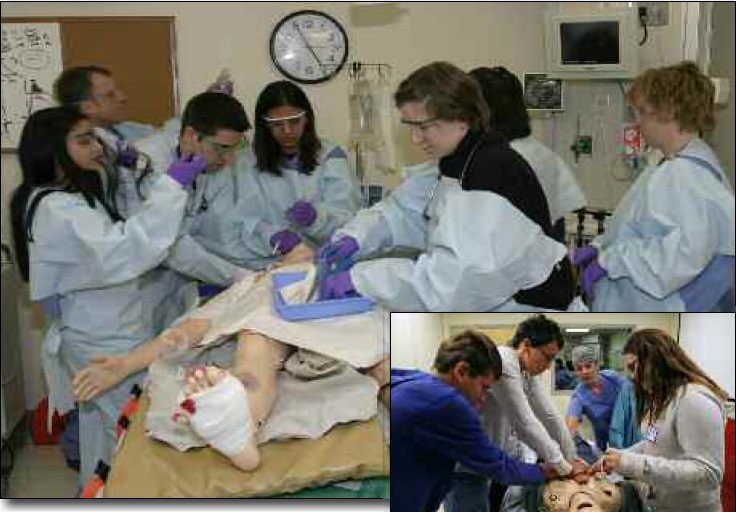➣ By Nicole Kissane & Charles Pozner

Figure 1: Using the endovascular trainer, this clinician is successfully placing a stent in the mannequin’s clogged coronary vessel.
Medical education has entered a virtual world. The Neil and Elise Wallace Simulation, Training, Research and Technology Utilization System Center at Brigham and Women’s Hospital, known as STRATUS, has taken the lead in teaching students and training clinicians through simulation. On the campus of the Brigham and Women’s Hospital in Boston, Massachusetts, STRATUS is home to high-tech mannequins that talk, breathe, have a palpable pulse, and can go into cardiac arrest. In addition to these human simulators, STRATUS also uniquely has a high-tech micro-simulation center for computer-based simulation and education, as well as a partial task simulation center for hybrid simulation and hands-on procedures. The full-scale operating room is complete with authentic anesthesia equipment, high definition laparoscopic monitors and surgical booms, real instruments, and scrub sinks.
This operating room also doubles as a birthing suite with a sophisticated mannequin that can deliver a baby and simulate postpartum hemorrhage events. Upon delivery, again with hybrid simulation, the suite can transform into a Neonatal Intensive Care Unit, with focus transitioned from delivery to neonatal care. STRATUS also has an “arcade” which contains laparoscopic surgical trainers, endoscopic simulators, ultrasound trainers, and Virtual Reality surgical simulators. The arcade is also the home to an endovascular suite that enables cardiologists, interventional radiologists, and endovascular surgeons to master sophisticated vascular catheterizations in a simulated environment.

Figure 2 (top): Trauma team members work together to save a life … in simulation.
Figure 3: Students interested in medical careers participate in emergency code training, practicing basic and advanced life support skills.
Using the experience of simulation as a catalyst for learning, STRATUS recognizes the primary importance of debriefing participants after each scenario. Based on adult learning theory, STRATUS is founded upon “learning by doing.” In addition to the hands-on clinical opportunities which ignite many insightful discussions related to clinical diagnosis and management, STRATUS also emphasizes the importance of teamwork and communication in the healthcare environment. Courses specifically designed for team training have shown to improve outcomes and provide learners with experience in high acuity, yet infrequent, scenarios. Code Team Training, Trauma Team Training, and Obstetrical Team Training are all examples of curricula designed specifically for maximizing teamwork. The curricula for these programs are created around a specialty-specific scenario, however, the focus of the debriefing is the same: communication, leadership, teamwork, safety, and outcomes.
STRATUS is available to every department throughout the hospital and provides each specialty with specific simulation-based training and educational opportunities. The learning community at STRATUS includes doctors, nurses, therapists, paramedics, and technicians. The future of STRATUS is focused around its learners by providing clinicians with the unique opportunity to improve performance – at the clinic, by the bedside, in the operating room, and during an emergency – where it matters most, and where patient safety is top priority.
About Brenda Wiederhold
President of Virtual Reality Medical Institute (VRMI) in Brussels, Belgium.
Executive VP Virtual Reality Medical Center (VRMC), based in San Diego and Los Angeles, California.
CEO of Interactive Media Institute a 501c3 non-profit
Clinical Instructor in Department of Psychiatry at UCSD
Founder of CyberPsychology, CyberTherapy, & Social Networking Conference
Visiting Professor at Catholic University Milan.









